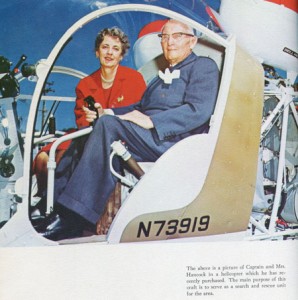G. Allan Hancock
Karl Gerber
January 1, 2023
 If you do not know who G. Allan Hancock is you need a remedial course in Los Angeles and California history. As the name suggests, he is Hancock Park. He inherited Rancho La Brea from his father.
If you do not know who G. Allan Hancock is you need a remedial course in Los Angeles and California history. As the name suggests, he is Hancock Park. He inherited Rancho La Brea from his father.
Rancho La Brea was a 1828 Spanish Land Grant of 4,439 acres. Although one of the smallest, today it contains some of Los Angeles’ most valuable real estate. G. Allan Hancock’s maternal grandfather Count. Agoston Haraszthy purchased the Rancho in the 1860s for $2.50 per acre after founding California’s first Anglo winery. This area of land covers most the Wilshire District, of course the Miracle Mile, and part of Hollywood. Haraszthy was a lawyer who hoped to mine for gold on the land. Henry Hancock married Haraszthy’s daughter. Henry Hancock died when G. Allen Hancock was eight, in 1883. Their home was on a knoll, facing present day Wilshire Boulevard, where the County Art Museum is today.
The scope of G. Allen Hancock’s legacy is beyond this post. The significance and rarity of the vanity publication, signed by G. Allen Hancock’s third wife Mariam (who died in 1992) is also beyond the scope of most Los Angeles historian’s imagination. Moreover, the book is in pristine condition. Having obviously been commissioned by Hancock in 1964, right before he died in 1965, it contains invaluable information not available anywhere else.
G. Allen Hancock’s accomplishments include successfully mining approximately 72 oil wells, founding the oceanography department of USC, making considerable donations to USC, helping develop Hancock Park, obviously coming in contact with Gaylord Wilshire, the Gilmores (as in Gilmore Oil, Gilmore Stadium, and now Farmer’s Market), helping develop Royal Woods in Encino and Hidden Woods in Sherman Oaks on the other side of Sepulveda. He is also responsible for Hancock College (originally called Hancock College of Aeronautics) in Santa Maria where he also had vast holdings including Rosemary Farm. Other accomplishments include founding California Bank.
While all of these accomplishments sound grandiose, without Hancock’s land sales the Los Angeles WOULD NOT have migrated West. Los Angeles WOULD NOT have developed as a car culture. The first supermarket would not have been built on Wilshire Boulevard. Department stores with parking in back would not have been built along Wilshire Boulevard and questionably the concept of the mall would never have existed.
At some point between 1913 and 1916 G. Allan Hancock donated the land where the County Art Museum, Tar Pits, and the George Page Museum now stand.
G. Allan Hancock sits on a pedestal with Los Angeles’ most important citizens.